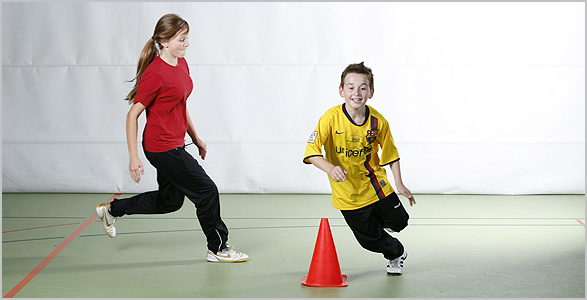6-minute Run (6min)
Back to overview
1. Test objective
Determination of general aerobic endurance.
2. Description of the task

In the 6-minute run, the goal is to cover as long a distance as possible in the given time. Normally, the 6-minute run takes place in a hall around the volleyball court (54 m per lap), but it can also take place outdoors on a 400-m running track (cf. Bös et al., 2009). The test can take place with 6-15 runners at the same time. The run is started and finished centrally by the main test leader. During the test, the time still to run is indicated in 1-minute intervals. During the 6 minutes, a speed as constant as possible should be run. In case of exhaustion, walking is also allowed, but subjects should not stop. At the end of the 6 minutes, each test subject remains standing on the spot.
For younger children, the use of a pacemaker for the first two laps has proven effective, so that the younger test subjects have a guideline speed. The pacemaker must not be overtaken.
3. Test materials
| 3.1 | Space requiremnets: a hall with a volleyball court or a 400 m track |
| 3.2 | Time and personal requirements: 2 test leaders can test up to 15 subjects within 10 minutes (for a better overview it is advisable to use several test leaders) |
| 3.3 | Equipment and materials: 6 cones (1 cone per corner and 1 cone each on the left and right at the level of the center line), stopwatch, start numbers according to the number of participants are suitable for better overview |
4. Test setup
The running track leads around the boundary lines of the volleyball court or around the 400 m running track.
In the case of the volleyball court, marking pylons (cones) are placed at the corners and on the center line. The cones are moved 50 cm along the line and 50 cm inwards.
5. Measurement recording
The reading for each subject is the distance traveled in meters in 6 minutes. Each test leader watches several test subjects and notes down each round. After the final whistle, the distance covered in meters for the last lap started is also noted. The total distance covered in the hall is then calculated as: Number of laps x 54 m + distance of the last lap.
Standard values
Age- and gender-specific norm values are available. The norm values were first published by Beck and Bös (1995) and later by Bös et. al (2009) in the DMT Manual.
6. Test instruction
In this test you have to run for 6 minutes. You have to cover as long a distance as possible. We will assign you to one of the 4 corners where you should line up. At the start command you start running. You will run around the volleyball court (or the 400 m track), but you must not run past the little huts on the inside. You run counterclockwise at a steady pace, so don't run to make it through the 6 minutes. If you get exhausted, just keep going and don't stop.
Every minute the time left to run is announced and the last 10 seconds are counted down loudly, i.e. 10-9-8-...-1-0. At "zero" you stop immediately and sit on the ground where you are until a test leader tells you that you can get up.
7. Special notes
Before the test starts, the test subjects are asked to check their shoelaces again. Test subjects are motivated again and again during the 6 minutes.
After the test, the test subjects are asked to walk one more lap to recover.
The test task is performed with sports shoes.
Sources of error
Test participants do not have a constant pace, but keep running, which leads to premature exhaustion. A constant pace must be emphasized.
Test participants may cut short and run past the little huts on the inside.
8. Sources
Beck, J. & Bös, K. (1995). Normwerte motorischer Leistungsfähigkeit. Köln: Sport und Buch Strauss.
Bös, K., Schlenker, L., Büsch, D., Lämmle, L., Müller, H., Oberger, J. & Tittlbach, S. (2009). Deutscher Motorik-Test 6-18. (DMT 6 - 18) (Schriften der Deutschen Vereinigung für Sportwissenschaft, 186). Hamburg: Czwalina.
